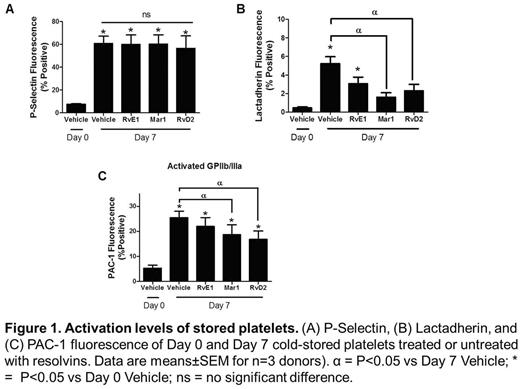Abstract
Introduction: Refrigeration of platelets in plasma is a promising alternative to conventional room temperature storage, but the cold temperature leads to increased levels of activation (i.e. P-Selectin and phosphatidylserine [PS]). Resolvins (Rv) are a class of specialized proresolving mediators (SPMs) that promote the resolution of inflammation and, more specifically, have been shown to regulate ADP activation of human platelets. In this study, we tested the hypothesis that the addition of Rv would help to reduce platelet activation during cold (4°C) storage and better preserve platelet function.
Methods: Apheresis platelets were collected from healthy donors (n=3-4) using a Trima Accel collection system. On the day of collection (Day 0) platelets were aliquotted into 4 mini-bags (10 mL). Three of the bags received either RvE1 (100μM), RvD2 (100 μM), or Maresin 1 (MaR1; 100 μM), while the final bag received 0.1% EtOH (Vehicle control). Treated mini-bags were incubated for 15 minutes with compound or vehicle prior to long-term storage at 4°C. The following assays were performed on Day 0 and Day 7 of storage: platelet count, Multiplate aggregation (ADP, Collagen, TRAP), and flow cytometry (GPIb expression, P-Selectin, lactadherin [PS], and PAC-1 [activated GPIIb/IIIa]). Data were analyzed using paired t-tests. Significance was determined as P <0.05.
Results: P-Selectin and PAC-1 expression in Day 7 Vehicle and compound-treated samples were significantly higher than Day 0 Vehicle levels (Fig. 1A, C). Compared to Vehicle at Day 7, RvD2- and MaR1-treated samples showed a significant reduction in PS expression (RvD2 vs Vehicle, P=0.031; MaR1 vs Vehicle, P=0.018) and PAC-I binding (RvD2 vs Vehicle, P=0.012; MaR1 vs Vehicle, P=0.036) (Fig. 1B, C). No differences in P-Selectin expression were observed for any of the compounds tested (Fig. 1A). TRAP response was higher in RvD2-treated samples compared to Day 7 Vehicle (P=0.047). ADP response was higher in MaR1-treated samples compared to Day 7 Vehicle (P=0.03). No differences in collagen aggregation were observed between samples. All SPM-treated bags resulted in higher platelet counts than Day 7 Vehicle.
Conclusions: Cold storage of platelets at 4°C has gained increased attention as an alternative to room temperature storage due to the lower risk of bacterial contamination, better preservation of platelet function, and the potential for a prolonged shelf life; however, increased levels of platelet activation and platelet clumping in cold-stored platelets limit shelf life. Results from our study suggest that the addition of SPMs (RvE1, RvD2, and MaR1) to cold-stored platelets helps minimize platelet activation and even preserve platelet function (RvD2, MarR1) during long-term storage. A platelet product with an extended shelf life would improve platelet inventories and expand access to under-served patients.
No relevant conflicts of interest to declare.
Author notes
Asterisk with author names denotes non-ASH members.


This feature is available to Subscribers Only
Sign In or Create an Account Close Modal